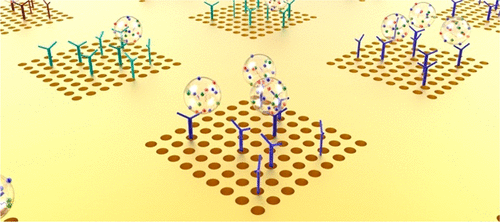Our official English website, www.x-mol.net, welcomes your feedback! (Note: you will need to create a separate account there.)
Plasmonic Sensors for Extracellular Vesicle Analysis: From Scientific Development to Translational Research
ACS Nano ( IF 17.1 ) Pub Date : 2020-10-29 , DOI: 10.1021/acsnano.0c07581 Lip Ket Chin 1, 2 , Taehwang Son 1 , Jae-Sang Hong 1 , Ai-Qun Liu 2 , Johan Skog 3 , Cesar M Castro 1, 4 , Ralph Weissleder 1, 5 , Hakho Lee 1, 6 , Hyungsoon Im 1, 6
ACS Nano ( IF 17.1 ) Pub Date : 2020-10-29 , DOI: 10.1021/acsnano.0c07581 Lip Ket Chin 1, 2 , Taehwang Son 1 , Jae-Sang Hong 1 , Ai-Qun Liu 2 , Johan Skog 3 , Cesar M Castro 1, 4 , Ralph Weissleder 1, 5 , Hakho Lee 1, 6 , Hyungsoon Im 1, 6
Affiliation

|
Extracellular vesicles (EVs), actively shed from a variety of neoplastic and host cells, are abundant in blood and carry molecular markers from parental cells. For these reasons, EVs have gained much interest as biomarkers of disease. Among a number of different analytical methods that have been developed, surface plasmon resonance (SPR) stands out as one of the ideal techniques given its sensitivity, robustness, and ability to miniaturize. In this Review, we compare different SPR platforms for EV analysis, including conventional SPR, nanoplasmonic sensors, surface-enhanced Raman spectroscopy, and plasmonic-enhanced fluorescence. We discuss different surface chemistries used to capture targeted EVs and molecularly profile their proteins and RNAs. We also highlight these plasmonic platforms’ clinical applications, including cancers, neurodegenerative diseases, and cardiovascular diseases. Finally, we discuss the future perspective of plasmonic sensing for EVs and their potentials for commercialization and clinical translation.
中文翻译:

用于细胞外囊泡分析的等离子体传感器:从科学发展到转化研究
细胞外囊泡 (EV) 从各种肿瘤细胞和宿主细胞中脱落,在血液中含量丰富,并携带来自亲代细胞的分子标记。由于这些原因,电动汽车作为疾病的生物标志物引起了极大的兴趣。在已开发的多种不同分析方法中,表面等离子共振 (SPR) 因其灵敏度、稳健性和小型化能力而成为理想技术之一。在这篇综述中,我们比较了用于 EV 分析的不同 SPR 平台,包括传统 SPR、纳米等离子体传感器、表面增强拉曼光谱和等离子体增强荧光。我们讨论了用于捕获目标 EV 并对其蛋白质和 RNA 进行分子分析的不同表面化学物质。我们还强调了这些等离子体平台的临床应用,包括癌症、神经退行性疾病和心血管疾病。最后,我们讨论了电动汽车等离子传感的未来前景及其商业化和临床转化的潜力。
更新日期:2020-11-25
中文翻译:

用于细胞外囊泡分析的等离子体传感器:从科学发展到转化研究
细胞外囊泡 (EV) 从各种肿瘤细胞和宿主细胞中脱落,在血液中含量丰富,并携带来自亲代细胞的分子标记。由于这些原因,电动汽车作为疾病的生物标志物引起了极大的兴趣。在已开发的多种不同分析方法中,表面等离子共振 (SPR) 因其灵敏度、稳健性和小型化能力而成为理想技术之一。在这篇综述中,我们比较了用于 EV 分析的不同 SPR 平台,包括传统 SPR、纳米等离子体传感器、表面增强拉曼光谱和等离子体增强荧光。我们讨论了用于捕获目标 EV 并对其蛋白质和 RNA 进行分子分析的不同表面化学物质。我们还强调了这些等离子体平台的临床应用,包括癌症、神经退行性疾病和心血管疾病。最后,我们讨论了电动汽车等离子传感的未来前景及其商业化和临床转化的潜力。



























 京公网安备 11010802027423号
京公网安备 11010802027423号